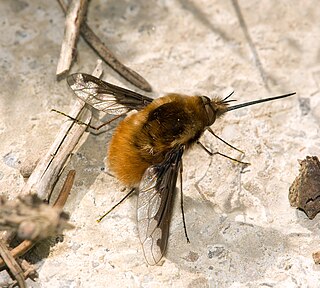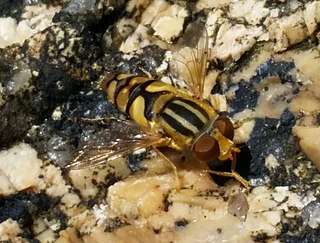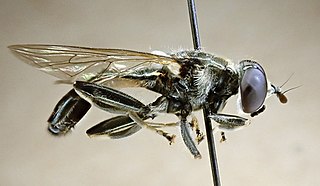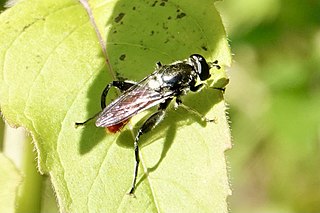
The Bombyliidae are a family of flies, commonly known as bee flies. Adults generally feed on nectar and pollen, some being important pollinators. Larvae are mostly parasitoids of other insects.

Teuchocnemis lituratus ,, the The Black Spur Fly , is an uncommon species of syrphid fly observed in the eastern half of North America. Syrphid flies are also known as Hover Flies or Flower Flies because the adults are frequently found hovering around flowers from which they feed on nectar and pollen. Adults are 10.5–15.4 mm (0.41–0.61 in)long, black with a yellow scutellum and hind tibia of male with spike. The larvae are unknown.
Xylota quadrimaculata ,, the Four-spotted Leafwalker , is a common species of syrphid fly observed in central and eastern North America. Syrphid flies are also known as Hover Flies or Flower Flies because the adults are frequently found hovering around flowers from which they feed on nectar and pollen. Adults are 8.2–11.3 mm (0.32–0.44 in) long, black with yellow-orange spots on the abdomen. The larvae of this genus live under bark in sap runs.
Chrysosyrphus latus , the Variable Wrinklehead, is a rare species of syrphid fly observed in the eastern United states and widespread in Canada. Hoverflies can remain nearly motionless in flight. The adults are also known as flower flies for they are commonly found on flowers, from which they get both energy-giving nectar and protein-rich pollen. The larvae are unknown.

Temnostoma alternans , the Wasp-like falsehorn, is a common species of syrphid fly observed throughout the northern and central United States and widespread in Canada. Hoverflies can remain nearly motionless in flight. The adults are also known as flower flies for they are commonly found on flowers, from which they get both energy-giving nectar and protein-rich pollen. Larvae burrow in moist decayed wood.
Parhelophilus obsoletus , the Unadorned Bog Fly, is a fairly common species of syrphid fly observed across Canada and the northeastern and central United States. Hoverflies can remain nearly motionless in flight. The adults are also known as flower flies for they are commonly found on flowers, from which they get both energy-giving nectar and protein-rich pollen. The larvae are unknown.

Helophilus latifrons, the Broad-headed Marsh Fly, is a species of syrphid fly observed throughout the United states, in lower Canada and the mountains on Mexico. Hoverflies can remain nearly motionless in flight. The adults are also known as flower flies for they are commonly found on flowers from which they get both energy-giving nectar and protein rich pollen. The larvae are aquatic feeding on decaying vegetation.

Parhelophilus laetus , the Common Bog Fly , is a common species of syrphid fly observed across norther North America. Hoverflies can remain nearly motionless in flight. The adults are also known as flower flies for they are commonly found on flowers, from which they get both energy-giving nectar and protein-rich pollen. The larvae are unknown.

Xylota angustiventris,, the Two-spotted Leafwalker , is an uncommon species of syrphid fly observed in northeast North America. Syrphid flies are also known as Hover Flies or Flower Flies because the adults are frequently found hovering around flowers from which they feed on nectar and pollen. Adults are 12.2–14.4 mm (0.48–0.57 in) long, largely black with two yellow spots on the abdomen in the male? The larvae are not known, but in this genus, are likely to be found in tree holes or bark to feed on sap.
Xylota subfasciata ,, the Large-spotted Forest Fly , is an uncommon species of syrphid fly observed widely across North America. Syrphid flies are also known as Hover Flies or Flower Flies because the adults are frequently found hovering around flowers from which they feed on nectar and pollen. Adults are 8.7–1,312.5 mm (0.34–51.67 in) long, black with large yellow abdominal spots. The larvae of this genus live under bark in sap runs.

Xylota bicolor ,, the Eastern Orange-tailed Leafwalker , is a rare species of syrphid fly observed across the eastern half of North America. Syrphid flies are also known as Hover Flies or Flower Flies because the adults are frequently found hovering around flowers from which they feed on nectar and pollen. Adults are 13.8–14.7 mm (0.54–0.58 in) in length, black with an orange abdomen The larvae of this genus live under bark in sap runs.
Sphegina lobata , the Yellow-lobed Pufftail, is an uncommon species of syrphid fly observed in notheastern North America. Hoverflies can remain nearly motionless in flight. The adults are also known as flower flies for they are commonly found on flowers, from which they get both energy-giving nectar and protein-rich pollen. Larvae found in accumulations of decaying sap under bark, usually in wet situations such as damp, shaded woodland and in partially submerged wood in streams and pools.

Sphegina rufiventris, the Black-horned Pufftail, is a common species of syrphid fly observed in the northestern United States. Hoverflies can remain nearly motionless in flight. The adults are also known as flower flies for they are commonly found on flowers, from which they get both energy-giving nectar and protein-rich pollen. Larvae are found in accumulations of decaying sap under bark, usually in wet situations such as damp, shaded woodland and in partially submerged wood in streams and pools.

Parhelophilus integer , the shiny bog fly, is a rare species of syrphid fly observed in the Eastern United States. Hoverflies can remain nearly motionless in flight. The adults are also known as flower flies, for they are commonly found on flowers from which they get both energy-giving nectar and protein-rich pollen. The larvae of this genus are the long tailed "rat-tailed" type.
Parhelophilus divisus the yellow-legged bog fly, is a rare species of syrphid fly observed in the northeastern United States. Hoverflies can remain nearly motionless in flight. The adults are also known as flower flies for they are commonly found on flowers, from which they get both energy-giving nectar and protein rich pollen. The larvae are the long tailed "rat-tailed" type.
Cheilosia capillata, the scar-horned blacklet, is an uncommon species of syrphid fly observed in the northeastern United States. Hoverflies can remain nearly motionless in flight. The adults are also known as flower flies for they are commonly found on flowers, from which they get both energy-giving nectar and protein-rich pollen. Larvae when known are plant feeders.
Cheilosia comosa , the prairie blacklet, is a species of syrphid fly observed in across North America. Hoverflies can remain nearly motionless in flight. The adults are also known as flower flies for they are commonly found on flowers from which they get both energy-giving nectar and protein-rich pollen. Larvae when known are plant feeders.
Hiatomyia cyanescens, the cobalt deltawing, is an uncommon species of syrphid fly observed in the northeastern United States. Hoverflies can remain nearly motionless in flight. The adults are also known as flower flies for they are commonly found on flowers from which they get both energy-giving nectar and protein-rich pollen. The larvae are unknown.
Total of 245 species either found or highly expected to be found in New York.











